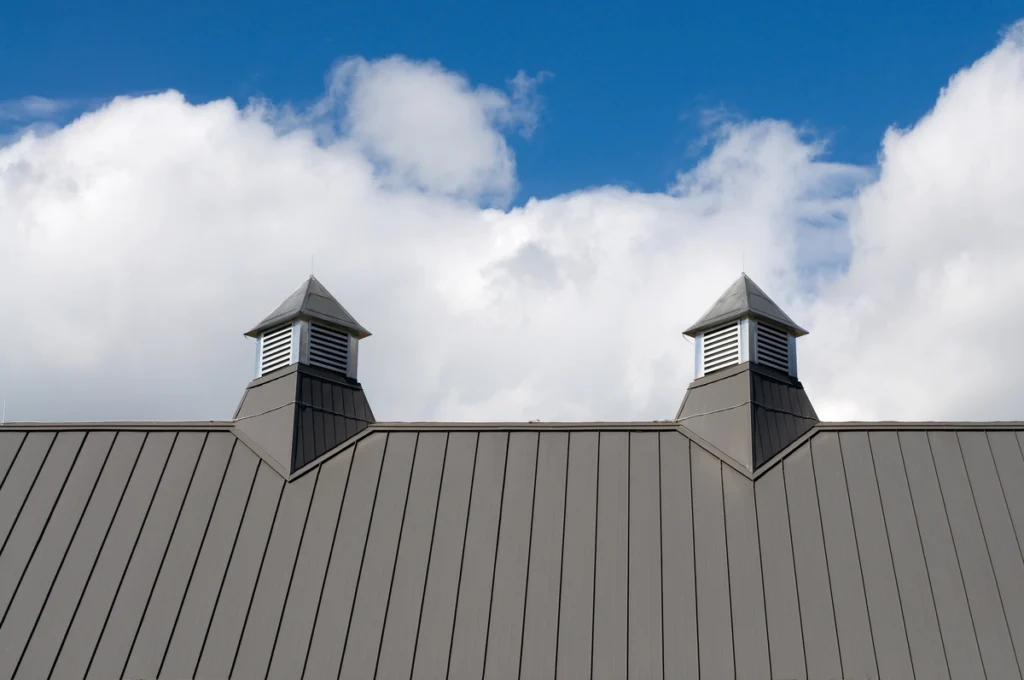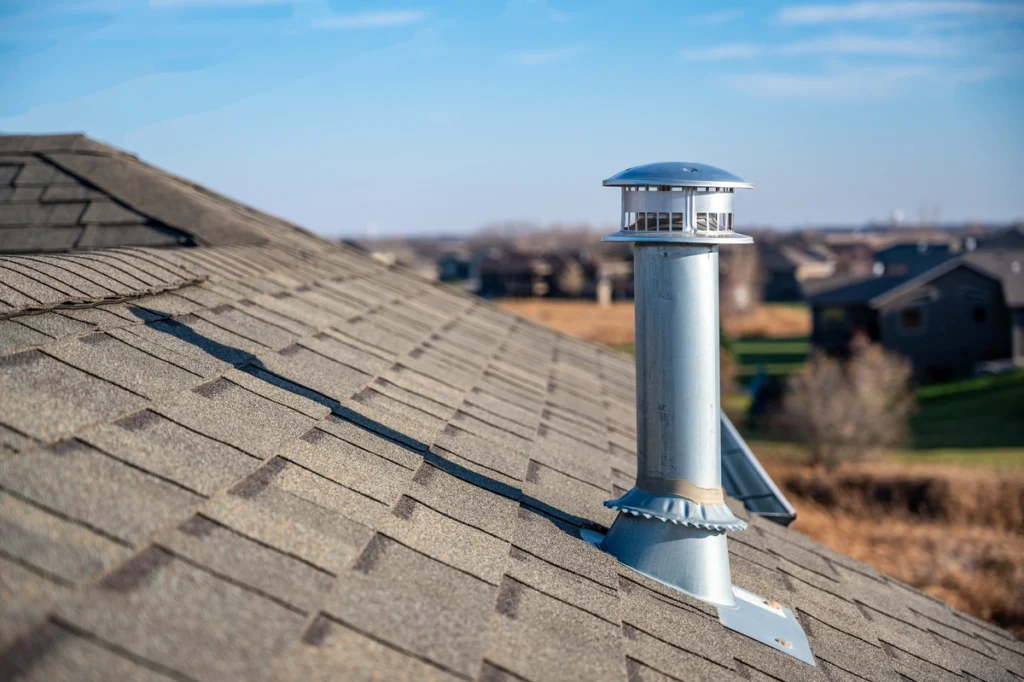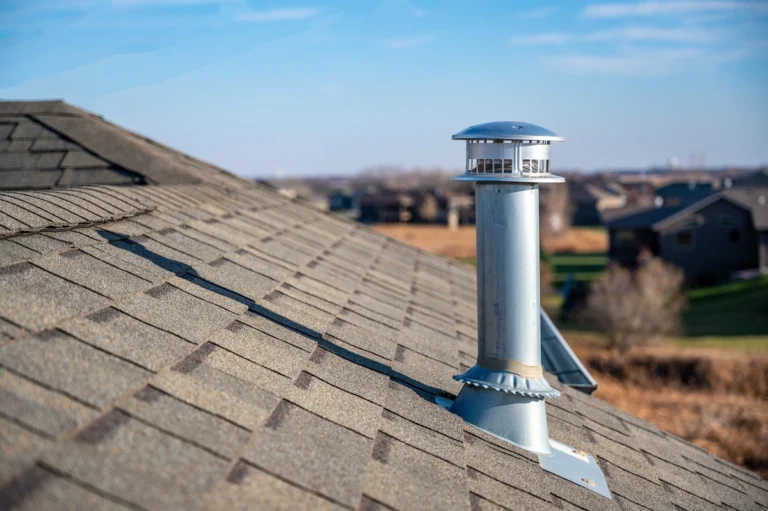
Roof ventilation is essential for maintaining a healthy and comfortable living environment and prolonging your roof’s lifespan. However, choosing the right one for your home or commercial space can be challenging with so many types of vents.
In this blog post, we’ll explore some of the most popular roof vents – from ridge vents to turbine and static vents – discussing their pros and cons to help you make an informed decision. Consulting with a professional roofing company can also help with your decision!
Key Takeaways
- Popular roof vents include ridge, turbine, static, and gable vents, each with pros and cons.
- Factors to consider when choosing the right type of vent include attic size and layout, weather conditions in your area, roofing material used on your home, and maintenance requirements.
Popular Types Of Roof Vents

Several popular roof vents include ridge vents, turbine vents, static vents, and gable vents.
Ridge Vents
Ridge vents are a popular roof vent that serve as an exhaust vent, helping maintain proper attic ventilation. These vents run along the roof ridge, hence their name, and provide an efficient way for hot air and moisture to escape from your attic.
They work with intake vents at the eaves or soffits, allowing cool air to flow into the attic while pushing warm air out through the ridge vents.
One advantage of ridge vents is their ability to blend seamlessly with your roof design due to their low profile. Moreover, they can easily be installed on various roofs – regardless of angles or valleys – making them a versatile option for homeowners considering a home renovation project.
Turbine Vents
Turbine vents, affectionately known as whirlybirds, are popular wind-driven roof vent that efficiently promotes air circulation within the attic space. These vents feature a sleek, aerodynamic design with spinning turbines that rotate in response to the slightest breeze.
An undeniable advantage of these roof vents is their capacity for continuous operation without needing electricity or additional power sources. This makes them an affordable and eco-friendly option for homeowners looking to improve their home ventilation systems.
In addition, turbine vents offer flexibility when ridge vents might not be possible due to limited space or specific construction requirements. However, some drawbacks include potential noise issues during high winds and slightly less efficient performance than other active venting options such as solar-powered or power vents.
Static Vents
Static vents, or box or mushroom vents, are popular roof ventilation systems that allow for passive air circulation in attics or other spaces within the structure.
These vents consist of static louvers placed near the ridge and evenly spaced to maximize airflow without relying on any mechanical assistance.
There are two main styles of these passive ventilation options: the mushroom vent and the box vent. Mushroom vents have a rounded shape resembling their namesake, while box vents are more rectangular.
Both function independently from one another but share a similar purpose – promoting air circulation by allowing warm air to escape through openings in the roof while drawing fresh outdoor air into the space below.
This process helps reduce excess moisture and maintain consistent temperatures throughout your home.
Gable Vents
Gable vents are a popular type of roof vent that uses horizontal or cross-ventilation to circulate attic air. These exhaust vents are typically located directly beneath the roof eaves on the sides of the house, at both ends of the peak of a gabled roof.
Gable vents help to remove hot and moist air from attics, protecting rafters and joists from fungi and extending their durability. Additionally, gable intake vents can be installed as small triangular vents along the peak of gables to improve attic ventilation.
These intake vents are visible but not unattractive and may be an effective solution for those seeking ventilation for their home’s roofing system.
Pros And Cons Of Each Type

Now that we’ve discussed the various types of roof vents let’s dive into their pros and cons. Starting with ridge vents, they are popular due to their efficient ventilation and lifespan extension ability.
Ridge vents run along the length of the roof peak and remove hot air from inside your attic, acting as natural coolers for your home.
Turbine vents work by spinning as the wind passes through them and removing heat from your attic. The primary advantage is no electricity is required for them to function.
Static vents come in different shapes and sizes but generally do not require moving parts or electricity to maintain airflow in your attic space.
Gable vents are mounted on the sides of gables, typically located at each end of a house under the peak of the gable roofline containing louvers that allow air movement throughout attics without having energy costs associated with mechanical ventilation systems like turbines or fans.
By understanding these pros and cons, you’ll make an informed decision when choosing which type of vent best suits your needs while keeping moisture prevention, ice dam prevention, and airflow improvement all top priorities on your list!
Choosing The Right Roof Vent: Factors To Consider
To choose the right roof vent, there are several factors to consider. Firstly, you need to determine the size and layout of your attic. In addition, different types of vents have varying ventilation capacities, so it’s crucial to find a suitable one for your specific needs.
Secondly, you should think about the weather conditions in your area.
Another essential factor to consider is the roofing material used in your home. Some materials may require a particular vent or installation method that differs from standard practices.
Finally, don’t overlook maintenance requirements when choosing a roof vent type. Regular upkeep is necessary to keep them functioning at optimal levels over time and prolong their lifespan.
Overall, by considering these various factors, homeowners can select the ideal ventilation option for their roofs and attics to maximize airflow and circulation while promoting temperature balance and moisture control for many years.
Conclusion

In conclusion, choosing the right type of roof vent can significantly impact the efficiency and performance of your ventilation system. Of course, each kind has pros and cons, but by carefully considering factors such as climate, roofing material, and attic space, you can choose the best one for your home or commercial building.
Proper installation and maintenance are crucial to ensure that your roof vents provide optimal airflow for years. Consult a professional roofing company before making a final decision!






